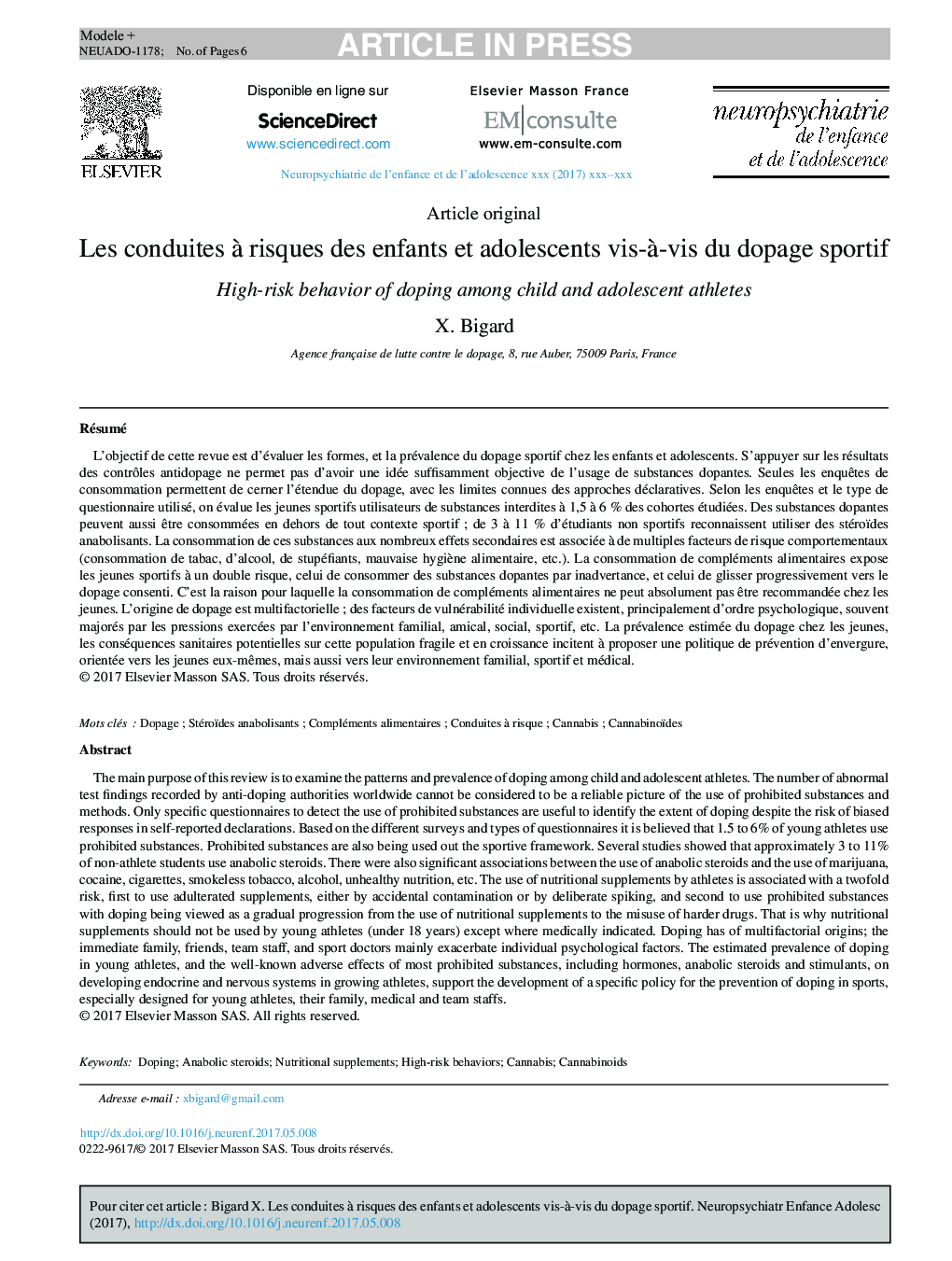| کد مقاله | کد نشریه | سال انتشار | مقاله انگلیسی | نسخه تمام متن |
|---|---|---|---|---|
| 7317033 | 1475518 | 2017 | 6 صفحه PDF | دانلود رایگان |
عنوان انگلیسی مقاله ISI
Les conduites à risques des enfants et adolescents vis-à -vis du dopage sportif
ترجمه فارسی عنوان
یک رفتار ریسک پذیری کودکان و نوجوانان در برابر دوپینگ ورزشی
دانلود مقاله + سفارش ترجمه
دانلود مقاله ISI انگلیسی
رایگان برای ایرانیان
ترجمه چکیده
هدف اصلی این بررسی بررسی الگوهای و شیوع دوپینگ در بین ورزشکاران کودک و نوجوان است. تعداد نتایج غیر طبیعی آزمایش که توسط مقامات ضد دوپینگ در سراسر جهان ثبت شده است، نمی تواند یک تصویر معتبر از استفاده از مواد و روش های ممنوعه باشد. تنها پرسشنامه های خاص برای شناسایی استفاده از مواد ممنوعه برای شناسایی میزان دوپینگ، با وجود خطر واکنش های متمایل در اعلامیه های خود، مفید است. بر اساس نظرسنجی های مختلف و انواع پرسشنامه ها اعتقاد بر این است که 1.5 تا 6 درصد ورزشکاران جوان از مواد ممنوعه استفاده می کنند. مواد ممنوعه نیز از چارچوب ورزشی استفاده می شود. مطالعات متعدد نشان داد که حدود 3 تا 11 درصد از دانشجویان غیر ورزشکار از استروئیدهای آنابولیک استفاده می کنند. همچنین بین استفاده از استروئیدهای آنابولیک و استفاده از ماری جوانا، کوکائین، سیگار، تنبلی غیر دودی، الکل، تغذیه ناسالم و غیره، ارتباط معنی داری وجود دارد. استفاده از مکمل های غذایی توسط ورزشکاران با دو برابر خطر ابتلا به مصرف مکمل های مجلل ، یا به علت آلودگی اتفاقی یا به صورت عمدی، و برای استفاده از مواد ممنوعه که دوپینگ به عنوان پیشرفت تدریجی از استفاده از مکمل های غذایی تا سوء استفاده از داروهای سخت تر مورد توجه قرار گیرد. به همین دلیل است که مکمل های غذایی نباید توسط ورزشکاران جوان (کمتر از 18 سال) مورد استفاده قرار گیرد مگر آنکه از نظر پزشکی مشخص شود. دوپینگ دارای ریشه های چند فاکتور است؛ خانواده فوری، دوستان، کارکنان تیم و پزشکان ورزش به طور عمده فاکتورهای روانی فردی را تشدید می کنند. شیوع تخمین دوپینگ در ورزشکاران جوان و اثرات نامطلوب شناخته شده اغلب مواد ممنوعه از جمله هورمون ها، استروئیدهای آنابولیک و محرک ها در توسعه سیستم های غدد درون ریز و عصبی در ورزشکاران در حال رشد، از توسعه یک سیاست خاص برای پیشگیری از دوپینگ در ورزش، به ویژه برای ورزشکاران جوان، خانواده، کارکنان پزشکی و تیم آنها طراحی شده است.
موضوعات مرتبط
علوم پزشکی و سلامت
پزشکی و دندانپزشکی
پریناتولوژی (پزشکی مادر و جنین)، طب اطفال و بهداشت کودک
چکیده انگلیسی
The main purpose of this review is to examine the patterns and prevalence of doping among child and adolescent athletes. The number of abnormal test findings recorded by anti-doping authorities worldwide cannot be considered to be a reliable picture of the use of prohibited substances and methods. Only specific questionnaires to detect the use of prohibited substances are useful to identify the extent of doping despite the risk of biased responses in self-reported declarations. Based on the different surveys and types of questionnaires it is believed that 1.5 to 6% of young athletes use prohibited substances. Prohibited substances are also being used out the sportive framework. Several studies showed that approximately 3 to 11% of non-athlete students use anabolic steroids. There were also significant associations between the use of anabolic steroids and the use of marijuana, cocaine, cigarettes, smokeless tobacco, alcohol, unhealthy nutrition, etc. The use of nutritional supplements by athletes is associated with a twofold risk, first to use adulterated supplements, either by accidental contamination or by deliberate spiking, and second to use prohibited substances with doping being viewed as a gradual progression from the use of nutritional supplements to the misuse of harder drugs. That is why nutritional supplements should not be used by young athletes (under 18 years) except where medically indicated. Doping has of multifactorial origins; the immediate family, friends, team staff, and sport doctors mainly exacerbate individual psychological factors. The estimated prevalence of doping in young athletes, and the well-known adverse effects of most prohibited substances, including hormones, anabolic steroids and stimulants, on developing endocrine and nervous systems in growing athletes, support the development of a specific policy for the prevention of doping in sports, especially designed for young athletes, their family, medical and team staffs.
ناشر
Database: Elsevier - ScienceDirect (ساینس دایرکت)
Journal: Neuropsychiatrie de l'Enfance et de l'Adolescence - Volume 65, Issue 7, November 2017, Pages 442-447
Journal: Neuropsychiatrie de l'Enfance et de l'Adolescence - Volume 65, Issue 7, November 2017, Pages 442-447
نویسندگان
X. Bigard,
